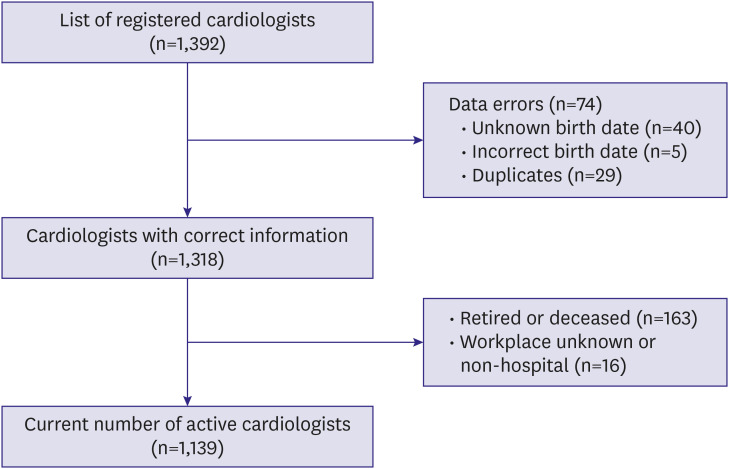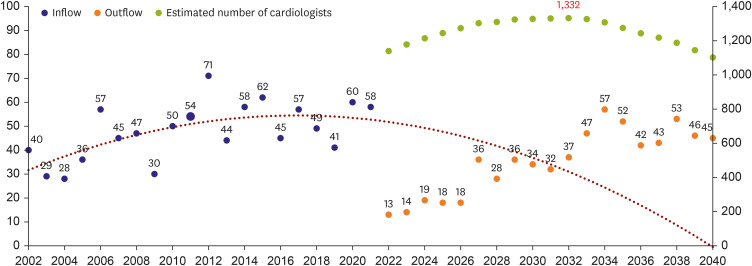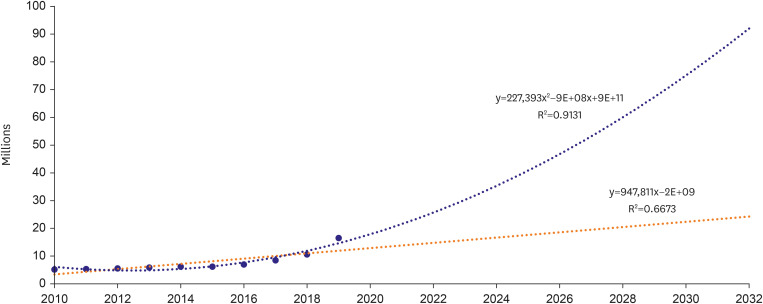Korean Circ J.
2024 Jan;54(1):1-12. 10.4070/kcj.2023.0262.
Estimation of Supply and Demand for Cardiologists in Korea
- Affiliations
-
- 1Department of Preventive Medicine, School of Medicine, The Catholic University of Korea, Seoul, Korea
- 2The Korean Cardiac Research Foundation, Seoul, Korea
- 3Department of Internal Medicine, Chungbuk National University Hospital, Chungbuk National University, College of Medicine, Cheongju, Korea
- 4Department of Internal Medicine, St. Vincent’s Hospital, The Catholic University of Korea, Suwon, Korea
- KMID: 2550602
- DOI: http://doi.org/10.4070/kcj.2023.0262
Abstract
- Background and Objectives
The objective of this study was to estimate the supply and demand for cardiologists in Korea and provide evidence for healthcare policy to ensure a stable and adequate workforce for optimal cardiovascular disease management.
Methods
Past trends of inflow and outflow of cardiologists were used to make crude projections, which were then adjusted based on demands of services to obtain final projections. Inflow of cardiologists was estimated using second-order polynomial regression and demand for cardiology care was estimated using linear regression.
Results
There were 1,139 active cardiologists who were under the age of 65 in clinical practice in Korea. The estimated number of cardiologists from 2022 to 2040 showed that the number of cardiologists would peak at 1,344 in 2032 and gradually decrease thereafter. We also estimated an increase of 947,811 cases of heart-related procedures annually from 2023 to 2032. The number of heart-related procedures per cardiologist would increase 1.4 times from 12,964 in 2023 to 17,862 in 2032. The estimated number of emergency patients per cardiologist under 50 years old would almost double from 544 in 2022 to 987 in 2032.
Conclusions
We expect significant shortage of cardiologists in Korea within the next 10 years. The number of emergency patients per cardiologist will increase by nearly 50%, leading to high individual workload for cardiologists. To prevent this imbalance between supply and demand, an organized and collective approach by the specialty of cardiology is imperative to produce a balanced workforce.
Figure
Reference
-
1. Health Insurance Review and Assessment Service. 6th Quality assessment of coronary artery bypass grafts. Wonju: Health Insurance Review & Assessment Service;2020.2. Statistics Korea. Annual report on the causes of death statistics. Daejeon: Statistics Korea;2021.3. Statistics Korea. 2022 Statistics on the aged. Daejeon: Statistics Korea;2022.4. Korea Institute for Health and Social Welfare. Survey on the status of healthcare workforce. Sejong: Korea Institute for Health and Social Welfare;2021.5. Korean Academy of Medical Sciences. Annual report of medical subspecialty in Korea 2021. Seoul: Korean Academy of Medical Sciences;2021.6. In : Wang J, editor. Results for burn-out survey of cardiologists. The 65th Annual Scientific Meeting of The Korean Society of Cardiology; 2021 Oct 16-18; Jeju, Korea. Seoul: Korean Society of Cardiology;2021.7. Mehta LS, Lewis SJ, Duvernoy CS, et al. Burnout and career satisfaction among U.S. cardiologists. J Am Coll Cardiol. 2019; 73:3345–3348. PMID: 31248556.8. Song SY. Cardiothoracic surgeons on verge of extinction in Korea [Internet]. Seoul: Korea Biomedical Review;2020. cited 2023 November 7. Available from: https://www.koreabiomed.com/news/articleView.html?idxno=9181.9. Fye WB. WB. Introduction: the origins and implications of a growing shortage of cardiologists. J Am Coll Cardiol. 2004; 44:221–232. PMID: 15282879.10. Narang A, Sinha SS, Rajagopalan B, et al. The supply and demand of the cardiovascular workforce: striking the right balance. J Am Coll Cardiol. 2016; 68:1680–1689. PMID: 27712782.11. Alter DA, Stukel TA, Newman A. The relationship between physician supply, cardiovascular health service use and cardiac disease burden in Ontario: supply-need mismatch. Can J Cardiol. 2008; 24:187–193. PMID: 18340387.12. de Teresa Galván E, Alonso-Pulpón L, Barber P, et al. Imbalance between the supply and demand for cardiologists in Spain. Analysis of the current situation, future prospects, and possible solutions. Rev Esp Cardiol. 2006; 59:703–717. PMID: 16938213.13. Chang HY, Hung PL, Liao CT, et al. Assessing the facilities and healthcare services for heart failure: Taiwan versus European countries. J Formos Med Assoc. 2022; 121:258–268. PMID: 33840545.14. Kanwal A, Sharma G, Surkova E. The assimilation of international medical graduates into the cardiovascular workforce: a tale of 2 countries. JACC Case Rep. 2020; 2:508–512. PMID: 34317278.15. American College of Cardiology. Cardiovascular workforce: sustaining an adequate workforce for patients [Internet]. Washington, D.C.: American College of Cardiology;2017. cited 2023 February 14. Available from: https://www.acc.org/latest-in-cardiology/articles/2017/02/14/14/42/cardiovascular-workforce-sustaining-an-adequate-workforce-for-patients.16. Javier E, Lars R, José LZ, et al. Trends and contexts in European cardiology practice for the next 15 years: the Madrid Declaration: a report from the European Conference on the Future of Cardiology, Madrid, 2-3 June 2006. Eur Heart J. 2007; 28:634–637. PMID: 17283000.17. Block P, Weber H, Kearney P. Cardiology Section of the UEMS. Manpower in cardiology II in western and central Europe (1999-2000). Eur Heart J. 2003; 24:299–310. PMID: 12581677.18. OECD. Health at a glance 2015. Paris: OECD;2015.19. Cannon CP, Gibson CM, Lambrew CT, et al. Relationship of symptom-onset-to-balloon time and door-to-balloon time with mortality in patients undergoing angioplasty for acute myocardial infarction. JAMA. 2000; 283:2941–2947. PMID: 10865271.20. Levine GN, Bates ER, Blankenship JC, et al. 2011 ACCF/AHA/SCAI guideline for percutaneous coronary intervention. A report of the American College of Cardiology Foundation/American Heart Association task force on practice guidelines and the society for cardiovascular angiography and interventions. J Am Coll Cardiol. 2011; 58:e44–122. PMID: 22070834.21. Jang JS, Han KR, Moon KW, et al. The current status of percutaneous coronary intervention in Korea: based on year 2014 cohort of Korean percutaneous coronary intervention (K-PCI) registry. Korean Circ J. 2017; 47:328–340. PMID: 28567083.22. Shin DH, Kang HJ, Jang JS, et al. The current status of percutaneous coronary intervention in Korea: based on year 2014 & 2016 cohort of Korean percutaneous coronary intervention (K-PCI) registry. Korean Circ J. 2019; 49:1136–1151. PMID: 31347316.
- Full Text Links
- Actions
-
Cited
- CITED
-
- Close
- Share
- Similar articles
-
- Variables in the projection of physician demand and supply in primary care
- Estimation of Demand and Supply for Occupational and Environmental Medicine Specialties in Korea (II): Demand Estimation and Demand-Supply Balance
- An Estimation on the Need and Supply for Visiting Nursing Services of Health Center in Seoul
- Estimated prospects of demand and supply of urologists in Korea over the next 10 years
- Future Supply of and Demand for Diagnostic Radiologists in Korea






